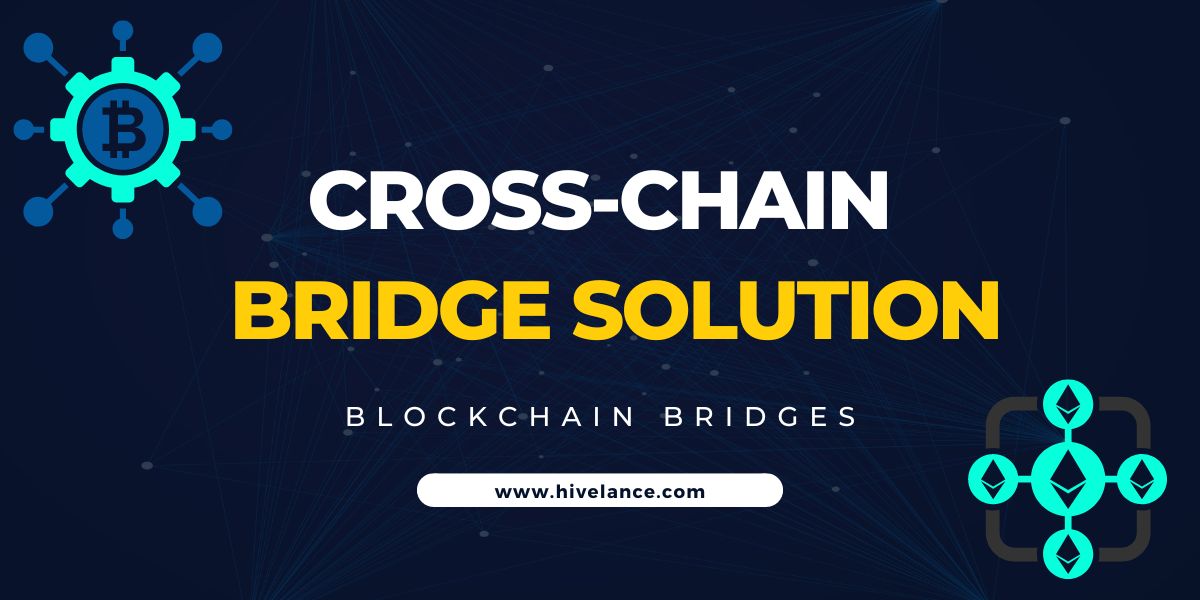Have you ever felt the time-consuming transactions that’s happening in bitcoin or Ethereum blockchains? This is due to the monopolization of single blockchains ruling the entire cryptocurrency investments. To improvise the interoperability and minimize transaction time in every blockchain, a cross-chain bridge was found. Let’s decode what is a cross-chain bridge, what are their advantages, applications of cross-chain bridges and who can do cross-chain bridging.
What is a cross-chain bridge?
Cross-chain bridge is the integration made between the two blockchain protocols to facilitate the transfer of digital assets or data. Because, every blockchain has a set of protocols, rules, and governance to regulate the ecosystem behind it. No one can change blockchain protocols easily. That’s the reason Blockchain cross bridging is here.
The bridging process is invented mainly to reduce the transaction time delay, minimize the network bandwidth, reduce gas fees, increase the use-cases. Cross-chain rectifies all the real-time problems faced in blockchain consensus.
Why adopt a cross-chain bridge?
As we said, cross-chain bridge addresses the most significant problems faced by the cryptocurrency industry. It can reduce gas fees greatly and helps in operating transactions on non scalable blockchains. The bridging enables freeflow of crypto assets between independent blockchain networks irrespective of rules and protocols.
The defi investments era began to boom and this led to massive increase of cross-chain bridges at the rate of 89% TVL. Because, defi is the world where everyone can freely participate in the financial investments. While coming to defi, everyone builds the dApps on different blockchain networks. Users need to convert their crypto assets into another blockchain system every time they are trying to invest. Cross-chain bridge solves the inter-connectivity problems reliably.
Advantages of Cross chain bridge development
1. High speed transaction
Most of the dApps are experiencing poor transaction time due to the high population of dApps operating on ethereum blockchain. The bottleneck of transactions gives the users a hefty time limit to do the single transaction. When implementing this cross-chain bridge, users can freely transact on the less used blockchains which enables high speed transactions. The bridging helps the two seperate blockchain economies to connect with each other without disturbing the protocols.
2. Reduced network usage
Heavy population of users on the single blockchain network causes the hindrance. The reason is due to the large number of decentralized applications that are built on the same network. Users rely on the single chain and actively participate in the same network again and again. This reduces the network speed and efficiency. Cross-chain bridge eliminates the need to rely on a single blockchain and enables crossflow of participation.
3. Wide interaction
The investors need a wide range of opportunities to get involved in choosing the right investment path. Defi coupled with cross-chain bridging can allow the investors to access thousands of dApps that are available in different blockchains. After the invention of the cross-chain bridge, entrepreneurs feel confident to execute their web3 idea and the defi is booming amidst all the crypto ups and downs.
4. Interoperability
Without blockchain’s interoperability nature, things like defi, NFT, Blockchain gaming would not be possible. The bridge solution has only the capacity to permit the interoperable standards in all blockchains. Whether you are moving your assets from bitcoin to ethereum or investing in NFT with ethereum, solana or any other chains.
5. Scalable
When adding more user load in the specific blockchain, scalability becomes the main problem. The blockchain network which is booming in the market can’t handle huge loads of data suddenly. To mitigate this risk of being loaded, cross-chain bridge can help and reduce the scalability problems.
Types of Cross-chain bridge solutions
- Ethereum bridge
- BSC bridge
- Cardono bridge
- Polkadot bridge
- Cosmos bridge
- Avalanche bridge
- Cosmos bridge
Applications of Cross-chain Bridge
The use cases of cross-chain bridges have been phenomenal. You can build dApps like,
Cross-chain NFT marketplace
Cross-chain NFT marketplace is the NFT buy/sell platform where users are allowed to exchange NFT for the blockchain network they wish for. The polygon based NFT marketplace took the mainstream only because of its low gas fees. When a cross-chain NFT marketplace is in place, the NFT community can experience a whole new ecosystem that eliminates all the real-time gas fee problems.
Also read - Cross-chain NFT marketplace development
Cross-chain crypto lending platform
Similar to the NFT marketplace, crypto lending platform is the place where crypto lenders and borrowers interact with each other for mutual benefits. The lender gets interest for the period of time and borrowers are lured with opportunities to invest in other crypto assets for multiplying their portfolio. lending platforms don’t have the limitations for its users due to different blockchain constraints. Cross-chain interoperability gives the ability to handle crypto loans
Cross-chain wallet
Cross-chain wallet is the decentralized crypto wallet that is engineered to handle any crypto transactions outside of specific blockchain ecosystems. The standard crypto wallet is capable of allowing a minimum number of cryptocurrencies that are derived from respective blockchains. But the cross-chain wallet has unlimited options to hold and store your cryptocurrency with a single key. There is no need to swap between each blockchain wallet for every transaction.
Cross-chain DEX
Cross-chain DEX is the decentralized exchange where traders are trading/exchanging their cryptos across different blockchain networks for the best price in the market. The atomic swaps, Automated market maker, and DEX aggregators are the common mechanisms followed in the cross-chain DEX. It adds the best user experience since all the blockchain networks are combined with interoperability transfer protocol. Users don’t need to switch wallets or exchanges for swapping their cryptos.
Hivelance’s expertise in Cross-chain bridge solutions
Hivelance’s blockchain expertise can help you to connect the two separate blockchain networks with seamless cross-chain bridge solutions. We are having strong experience in delivering Native bridges, oracle based bridges, message passing bridges, and Liquidity networks.
We know the fundamentals of cross-chain bridge development and provide you with the cross-chain interoperability protocols(CCIP) as guaranteed. With value added services like technical support post implementation and add-on customization, we back up your cross-chain projects at any cost.
 Trends
Trends
 Crypto
Crypto
 Web 3.0
Web 3.0
 AI
AI
 Blockchain
Blockchain
 Fintech
Fintech
 Company
Company


















